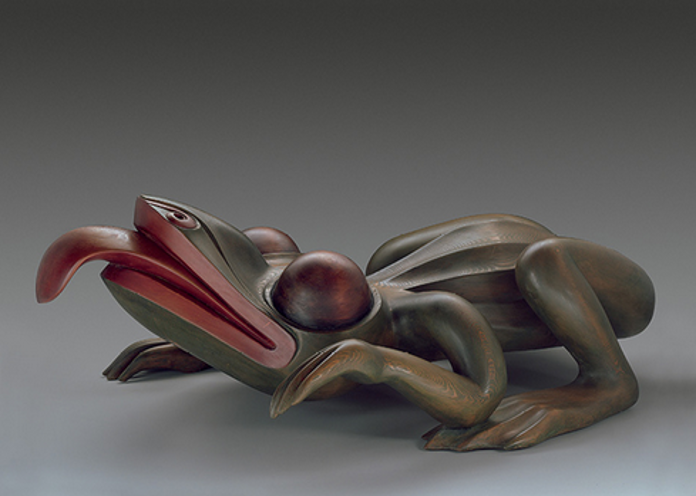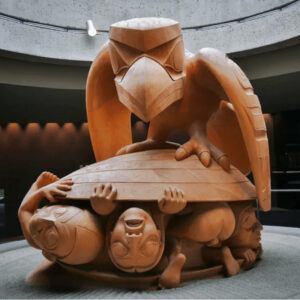Phyllidula—The Shape of Frogs to Come 1984–85

Bill Reid, Phyllidula—The Shape of Frogs to Come, 1984–85
Red cedar, stain, 42.5 x 87 x 119 cm
Vancouver Art Gallery
Phyllidula—The Shape of Frogs to Come, Bill Reid’s last large wooden sculpture, takes as its focus the Frog, whom Reid described as “the ever-present intermediary between two of the worlds of the Haidas, the land and the sea.” With crouched legs, a rigid back, and a tongue extended outward, Phyllidula appears smooth and limber and, with bulging hemispherical eyes, poised to make an unpredictable move. Phyllidula is both humorous and tricky, sticking its tongue out at us in a lusciously taunting way. The sculpture has some classic Haida features, like the graphic red lips, nostrils, and extended tongue contrasting with its green body. Its asymmetric and naturalized in-the-round form is free from any confining structure. Phyllidula has a decidedly contemporary presence.

The amphibious Frog is an allegorical figure that is inspirational to Reid: a being capable of occupying two worlds simultaneously. The Shape of Frogs to Come evokes the being and becoming of worlds that cannot exist in isolation—worlds that create possibilities through their slippery entanglement, a contact zone. In the mid-1980s, when Phyllidula was produced, Reid was in the midst of many major projects and all the while was contending with the Parkinson’s disease that limited his capacities. Martine J. Reid (b.1945) remembers the difficulty Reid experienced while carving this particular sculpture. The wood was “nagging” Bill, she said, and he was plagued with nightmares.
The title Phyllidula reminds us of Reid’s knowledge of a broad and worldly range of English literary works. He was deeply inspired by them and was able to passionately, humorously, and very capably articulate his thoughts on his literary influences. He loved poetry, and could quote endlessly from myriad sources, be they American, European, or other. In this instance, it is the words of the American poet Ezra Pound that are referenced and make us wonder who Phyllidula—in Pound’s poem a scrawny but amorous creature who has been awarded great pleasure by the gods—is in Reid’s world.
George Rammell (b.1952) notes that Reid employed English literature to “relocate the grand narratives of the Haida in a linguistic sea of puns and metaphors.” He remembers the antics Reid incited when he placed Phyllidula, “his sardonic cedar raven in a frog’s body,” on a wheeled dolly and took a “humorous stroll around Granville Island . . . with [Phyllidula] on a leash like an obedient Haida pet.” This can be contrasted with Robert Bringhurst’s observations in The Raven Steals the Light, in which he writes, “Moving in and out of the water, in and out of the mouth, the Frog knows more than other creatures about the elusiveness of things, as well as about the powers of sexuality and transformation.” The master of many tricks, Reid kept his audiences entranced and entertained in his guessing game.

 About the Author
About the Author
 More Online Art Books
More Online Art Books
 Acknowledgements
Acknowledgements